Everyone is talking about them, everyone wants to use them: Data Clean Rooms are the must-have solution in 2022. They promise to enable brands, media owners, agencies, and data providers to collaborate easily and securely with customer data. These collaborations empower organizations to maximize the performance of their data, with complete data protection.
On March 30th, 2022, we hosted a live discussion on collaboration in the Data Clean Room, talking with Peter Markey from Boots, Lara Izlan from ITV, Kapil Sampanthan from Kantar, and Sarah Kenny from Wavemaker North. Alongside our own Stuart Colman, these industry leaders discussed how Data Clean Rooms are enabling organizations across the entire advertising ecosystem to unlock the full potential of their data, delivering richer data-driven experiences that prioritize consumer privacy and deliver value to companies.
The desire to collaborate is not new
There are a lot of reasons for using Data Clean Rooms and for collaborating with others. Lara perhaps put it best: “Datasets are better together.”
And she is right, but collaboration as she said is not new.
“It used to be that people go, first-party data is really important obviously, but not really knew how to use it, how to actually extract value from it, and we're getting the point now where there are real mechanics that can start to unlock that value and that is the motivation for brands to look at their first-party data strategy again and join it all up.”
Sarah added to that point:
“One of the really exciting things about clean rooms […] is how that technology […] helps […] make the best use of data across the whole ecosystem. [...] The fact that brands like Boots are willing and able to share their data in a compliant and safe way […] it just makes those conversations easier, the door is a bit more open, and there’s an ease of entry now that I think the conversation just flows and then we can get the activities and use cases and campaigns and insight over the line that ultimately allows organizations to understand the value of that data and then really think about what that value is for the consumers to collect that data in the first instance.”
But what’s new is the technology and the mechanics. Kapil agreed:
“When it comes to data clean room technology the biggest selling point for us is the ability to move quickly, be agile but collaborate in a PII compliant manner and for us, we see an opportunity there that we simply never had five years ago.”
Lara described very eloquently what that opportunity looks like for the industry:
“It's amazing now to have the technology to enable the trust needed in order to move forward because data for many companies it's quite a sacred asset. With our own first-party data sets you know typically we have either depth, so we know a lot about a relatively tight audience pool or on we have breadth so, similar to ITV and potentially also Boots, we have a wide audience pool but our insight is in some sense limited by the services and products that we provide or the cadence with which those users engage with us. For the vast majority of us – except for big tech probably – we're either in one or the other pool […] I think by bringing these data sets together you can start to bring together the best of both.”
Treat the data with the care and respect it rightly deserves
With these opportunities now possible through Data Clean Rooms, one thing all four of our panelists agreed on was collaborating in a privacy-compliant way and regaining a bit of that trust we have been lacking. Sarah looked at it from the agency perspective and talked about how Data Clean Rooms make collaboration so much easier.
“I think the notion of a data clean room […] just opens the door to some of these things we’ve wanted to do for a long time and we’ve tried but maybe fallen at hurdles like compliance.”
For Peter, the important part of collaboration is having partners you can trust and have absolute confidence in:
“It's really important to work with partners who've got the same appetite and the same level of security around the use of data that we have. And the data you hold on customers is just really special and really precious so you've got to treat that data with the level of care that it rightly deserves. […] You need a really great partner with great technology that's super secure that you have absolute confidence in and we've definitely got that with InfoSum.”
Kapil agreed that first-party data should be protected when collaborating: “The beauty of being able to work within a data clean room is that pretty much covers that issue, nothing is being shared so when we deploy our data into a clean room – i.e. InfoSum – we are assured that the data will not leave that Bunker.”
Talking about partners and opportunities, Sarah added that the new technologies will get companies to collaborate that couldn’t before:
“The sort of notion that it is privacy-safe, and the data is secure and all of those sorts of things is hugely important. It's what potentially gets some people to the table who haven't been before, who haven't thought about or been willing to share their data in the past.”
The focus on data privacy is not just about helping companies and new opportunities that are opening up, in the end it is all about the consumers. Sarah touched on being transparent and helping to build back some trust.
“For consumers, it's going to be about transparency and making sure […] that privacy statements and all of those things are really consumer-friendly and it's transparent. What's happening with their data is going to be hugely important so that we don't fall into the mistrust. [..] The notion that we have a piece of technology that is privacy safe is hugely exciting and is helping kind of build back some of that trust but allowing all of the exciting things that we've all talked about from a collaboration point of view, I think we just need to make sure that we continue to educate both inside marketing but also consumers out there in the wider world.”
Paying back the consumer
Adding to that we should not only keep the data safe and secure but treat consumers with respect, and give them something in return for their data. Lara commented:
“It’s our responsibility to use the data that we capture through that value exchange in a way that is paying back to the consumer. Better content, more relevant content, more relevant experiences. Not just from an advertising perspective, from a product perspective, personalized experiences that actually make their engagement […] so much more meaningful, so much more enjoyable.”
For Peter it’s all about understanding the customers and deepening that relationship:
“It's all about the best way to reach those audiences and there's obviously this opportunity for us to enhance that data and that understanding of that data that then helps us but also helps our supplier base as well. This whole thing around deepening customer relationships is what it's about. The more we know about our customers the more steps we can take to actively reach them. […] Data and customer relationships are at the fabric of our business. We've got just under 15 million advantage card holders [..] so continuing to invest in growing that and supporting and nurturing that is a really important part of what we do. The relationships with customers are really important to us given the depth and breadth of what we do from healthcare to pharmacy through to beauty and it's a really important part for us around how we better reach that base.”
Cookies: Something that happened to us as opposed to consciously agreeing
Talking about collaboration and new technology it was just a matter of when the topic was going to be mentioned- cookies. For Lara, the way we collaborate now is much more transparent for consumers and something they can actively agree to.
“It's about the value exchange, it's about being upfront about the uses of data […]. That mechanics of actually entering your details is a very conscious activity and I think many of us are kind of before we sign anything we're going to read at least a little bit about what we're signing. It's a conscious decision of opting into a value exchange whereas with cookies it has always felt like something that happens that's slightly behind what I can see. And even though we tried to fix it by pop-ups or whatever it is it always felt like it's something that was happening to us as opposed to something that we've kind of consciously kind of entered into.”
Learnings: It's not just about putting in place the technology
Boots and ITV have been collaborating for a while now and we asked Peter and Lara to share some learning with us from that collaboration. Peter’s biggest learning was that a lot of education is required.
“Be ready for the education required, […] you've suddenly got this new thing in the mix in terms of how you're working with your media agency […] and it's just adjusting to that. But we've been actively talking about mass personalization and working using data for over a year now. We've got interesting stats: around 2018 / 2019 about six percent of our media was put using first-party data and it's now up at 30 percent on most campaigns.”
For Lara the biggest learning was that it’s not just putting the technology in place:
“The biggest learning is it's not just about putting in place the technology. […] It's about the people and the process, internally quite a lot but also kind of the touchpoints with the external parties as well, […] getting all the right people involved at the right points of time.”
Collaboration is about working together – with other parties as well as internally – just like Lara said. And to the point Lara made about datasets being better together, Peter summarized collaboration excellently: “In partnership, we all succeed together.”
Watch the full live discussion on-demand to hear more from these industry leaders.







